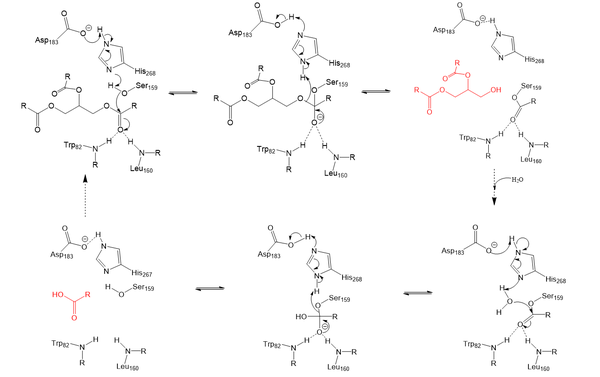Introduction
is an important enzyme for the breakdown of triglycerides in the body.

Purpose of LPL: to catalyze the breakdown of a triglyceride into a diglyceride and create one free fatty acid
A
lipase is an enzyme that is capable of catalyzing the
hydrolysis of fats/lipids which are consumed through oils. It is encoded by the
p22 region in chromosome 8. Once synthesized, it is secreted into the interstitial space in several tissues. The main site of action for is in the
capillary lumen within muscle and adipose tissue. The function of this lipase is to hydrolyze
triglycerides of very low density lipoproteins (
VLDL) and to aid in the delivery of lipid nutrients to vital tissues. The enzyme is commonly found on the surface of cells that line blood capillaries. Two different lipoproteins are essential to break down triglycerides. One of the lipoproteins is utilized to transport fat into the bloodstream from different organs. The lipoproteins essential, in the transport of fat from the intestine are referred to as
chylomicrons. VLDL are utilized in carrying triglycerides from the liver into the bloodstream. The hydrolysis of triglycerides by lipoprotein lipase results in fat molecules to be used by the body as energy or stored in fatty tissue.
Structural Overview
is assumed to only be active as a , however, previous studies have argued that the lipase can be active in its . (https://www.ncbi.nlm.nih.gov/pmc/articles/PMC6442593/) The N-terminal domain of lipoprotein lipase is known to consist of an alpha/beta hydrolase domain, which is composed of six alpha helices and ten beta-strands. This domain creates an .The C-terminal domain of lipoprotein lipase is composed of twelve beta strands which form a "".
Mechanism
Lipoprotein Lipase functions to catalyze the hydrolysis of one ester bond of triglycerides in order to remove one fatty acid tail and turn the triglyceride into a diglyceride. It does this by utilizing a simple serine hydrolase mechanism, in which it uses a composed of Asp183, His268, and Ser159 to catalyze the hydrolysis. His268 serves as a base catalyst by deprotonation of Ser159, which can then serve as the nucleophile. The transition state of the catalysis is stabilized by the backbone of Trp82 and Leu160 residues, forming the . The hydrolysis results in the formation of one free fatty acid and a glycerol with two fatty acid tails.

Serine hydrolase mechanism utilized by LPL to catalyze the breakdown of one ester bond of a triglyceride. Compounds colored red are the products of the hydrolysis.
Relevance & Disease
LPL is an extremely important enzyme, in that it is responsible for the proper breakdown of certain fats in the body. LPL breaks down triglycerides carried in chylomicrons, otherwise known as very low-density lipoproteins (VLDL). Chylomicrons carry digested fats in the form of triglycerides out of the small intestine and into the bloodstream. LPL recognizes the chylomicrons, and hydrolyzes the associated triglycerides.[1] When triglycerides are not broken down properly and are allowed to build up, they can lead to increased plasma triglyceride levels (hypertriglyceridemia) and cholesterol buildup. Hypertriglyceridemia is very unhealthy and is the leading cause of Coronary Artery Disease in America.[2] Cholesterol buildup is caused by excess fats (triglycerides) and is a similarly serious issue with regards to obesity and heart disease in the United States as it can lead to plaque buildup in arteries and veins, which restricts blood flow.[3] Chylomicronemia, which is defined as an excess of chylomicrons in the blood, is the disease characterized by the body being deficient in LPL resulting in persistent hypertriglyceridemia. This disease causes the body to be unable to digest very much ingested fats, and often leads to severe abdominal discomfort and several episodes of acute pancreatitis.[4] In short, without LPL in the body, triglycerides are unable to get broken down, and there is a much higher likelihood of developing coronary & metabolic based diseases.
Structural highlights
GPIHBP1
Glycosylphosphatidylinositol-anchored high-density lipoprotein-binding protein (GPIHBP1) is necessary for function and stability.
GPI/LPL interface (w/labels):
Calcium Ion Stabilization
Lid Region


